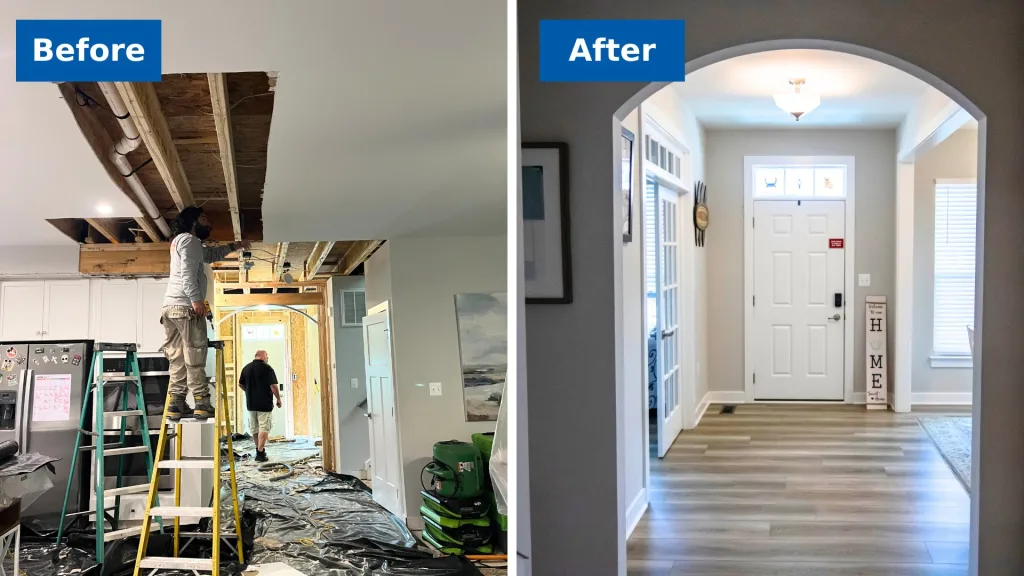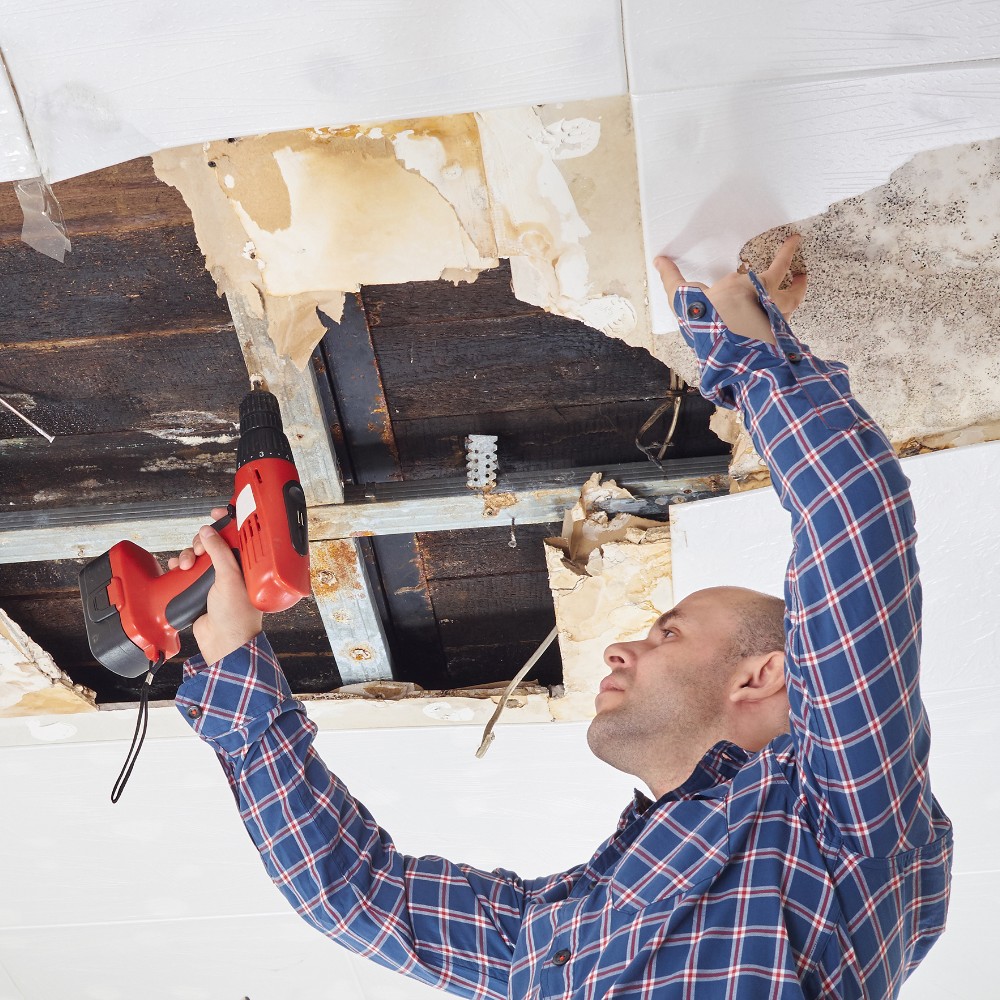How to Choose the Right Flood Damage Restoration Company for Your Needs
Necessary Actions to Comply With for Efficient Water Damage Restoration in Your Home
When faced with water damages in your home, understanding the essential steps for effective restoration can make all the difference. You need to analyze the damage and warranty safety prior to dealing with the trouble. Quiting the resource of water is crucial, but it's just the beginning. There's a collection of actions you need to take to secure your residential or commercial property from further concerns when you have actually taken care of that. Let's discover what you ought to do following.
Examine the Damage
The first action is to examine the damages thoroughly when you find water damages in your home. Beginning by determining the resource of the water intrusion. Look for leaks, burst pipelines, or other problems creating the issue. Next off, check out the impacted areas for visible indicators of damage, consisting of bending, discoloration, or mold and mildew development. Don't neglect to look in covert places like behind walls or under flooring, as water can seep right into these locations unnoticed.Document the damages by taking clear images and notes. This will certainly help you when discussing the scenario with your insurance copyright or restoration professionals. Take note of the kind of materials influenced, as various materials need different restoration techniques. Evaluate the extent of the damages. Is it minor or considerable? Comprehending the scope will direct you in determining whether to manage it on your own or call the professionals for a much more substantial remediation process.

Guarantee Security
Prior to you start any kind of remediation work, assuring your safety and security is important. Initially, analyze the condition of your home. If the water's deep or if you discover electric dangers, do not get in the area. Shut off the electrical energy and gas supply to stop crashes. Use protective gear like gloves, boots, and masks to secure on your own from impurities or mold.It's essential to remain aware of your environments; look for unsafe surfaces and sharp items. If the water is from a sewage backup, treat it as contaminated materials. Keep kids and pet dogs away from impacted locations to avoid exposure.Once you've taken these safety measures, you can wage the reconstruction procedure. Bear in mind, your safety precedes, and if you're ever unsure, it's ideal to seek advice from an expert. Taking these actions will help guarantee you prepare to tackle the restoration safely and effectively.
Stop the Resource of Water
After ensuring your safety and security, the following step is to stop the source of water. Identify where the leak is coming from. Maybe a ruptured pipe, a malfunctioning device, and even hefty rain going into with a harmed roof. If it's a plumbing problem, shut off the major water system to your home to prevent additional flooding. For devices, disconnect them and shut down their water valves.If the resource is outside, like rainwater, attempt to divert it far from your home making use of sandbags or other barriers. For minor leaks, you may be able to utilize tape or a sealant temporarily till an expert can repair it. Bear in mind, addressing the source promptly is vital to lessening damage and avoiding mold and mildew growth. Once you've stopped the water, you'll remain in a better placement to relocate on to the following action in the repair process.

Remove Excess Water
Act rapidly to get rid of excess water, as standing water can cause a lot more substantial damage and mold development. Collect your tools: a wet/dry vacuum, pails, and towels. You can utilize towels to soak up the moisture if the water is superficial. For much deeper water, a wet/dry vacuum cleaner is your best bet. Make certain to empty the vacuum cleaner frequently to avoid overflow.If the water is polluted, like from a sewage backup, wear safety equipment, consisting of masks and handwear covers, to keep yourself secure. When you've gotten rid of as much water as possible, look for concealed pockets of moisture in edges and under furniture, as these can harbor mold.Don' t fail to remember to switch off electric appliances and power electrical outlets in wet locations to avoid risks. This first action is essential in lessening damages and setting the phase for a successful repair process.
Dry and Dehumidify the Location
It's important to dry and dehumidify the area thoroughly as soon as you've removed the excess water. Beginning by utilizing dehumidifiers efficiently to draw moisture out of the air and stop mold development. Watch on moisture degrees to guarantee the area dries out completely.
Get Rid Of Standing Water
To efficiently deal with water damages, you need to concentrate on eliminating standing water as quickly as feasible. Start by gathering essential devices, like a wet/dry vacuum cleaner or a pump, relying on the quantity of water. A vacuum needs to do the method if the water is shallow. For bigger amounts, a pump is much more reliable. While functioning, see to it to put on safety equipment to keep on your own safe from contaminants. As you eliminate the water, take notice of concealed areas like under furniture or in edges where water may accumulate. Your space will certainly begin to dry out as soon as you've removed the majority. This action is vital, as sticking around water can cause mold development and more comprehensive damage.
Use Dehumidifiers Effectively
Exactly how can you properly make use of dehumidifiers to dry and evaporate your room? Start by placing your dehumidifier in the most affected area, preferably where water damages is most severe. See to it to shut all doors and windows to produce a covered environment. Activate the dehumidifier and established it to the ideal moisture level, typically around 30-50%. Vacant the water collection tank often, or take into consideration making use of a model with a article source continuous drainage option for ease. When possible, make use of fans to boost airflow, helping the dehumidifier work extra effectively. Keep the dehumidifier running until you're positive that the area is extensively dried out, protecting against mold and mildew growth and extra damages (Smoke Damage Restoration). This step is necessary for effective water damages remediation
Monitor Moisture Levels
Tracking moisture degrees is vital throughout the drying procedure, as it helps assure your area remains without excess dampness. Spend in a trusted hygrometer to track humidity properly. Preferably, you want to preserve levels between 30% and 50%. You may need to adjust your followers or dehumidifiers to boost air flow if moisture readings increase over this range. Inspect the readings routinely, particularly in check my blog locations vulnerable to wetness, like cellars or restrooms. If you observe relentless high humidity, consider enhancing air flow or utilizing extra dehumidifiers. Remaining on top of these degrees not only speeds up the drying out procedure but also prevents mold development, ensuring your home keeps comfortable and risk-free.
Tidy and Disinfect Affected Surfaces

Bring back and Fix Your Home
After cleansing and disinfecting the impacted areas, it's time to restore and fix your home. Begin by evaluating the damage. Inspect for structural problems, like damaged floors or wall surfaces, and deal with any kind of needed fixings. Changing damaged drywall or flooring is important for both aesthetics and safety.If your furniture or belongings were impacted, take into consideration whether they can be recovered or require replacement. Tidy or skillfully bring back items where possible.Next, touch and repaint walls up any locations that need interest. This not only enhances appearance yet likewise shields surfaces from future water damage.Don' t neglect to inspect your plumbing and devices for leaks, ensuring every little thing's working correctly. Take into consideration mounting a dehumidifier to protect against future wetness problems. By taking these actions, you'll restore your home to its former magnificence and create a much safer living environment.
Regularly Asked Questions
The Length Of Time Does Water Damage Repair Normally Take?
Water damages remediation usually takes anywhere from a few days to numerous weeks, depending on the degree of the damages (Flood Damage Restoration). You'll desire to evaluate the circumstance swiftly to lessen further problems and assure appropriate reconstruction
Will My Insurance Policy Cover Water Damage Restoration Costs?
Your insurance policy may cover water damage remediation costs, yet it depends upon your policy. Inspect your coverage information and contact your insurance representative to clarify what's included and what you need to sue.
Can I Handle Water Damages Reconstruction Myself?
You can take care of water damages remediation on your own, however it's essential to analyze the scenario first. If it's considerable, you might wish to call professionals. Constantly prioritize security and assure you've obtained the right tools.
What Are the Signs of Hidden Water Damages?
You might notice signs of surprise water damage like distorted walls, mildewy odors, or discoloration. If your floorings feel squishy or you spot mold and mildew, it's time to check out better before the circumstance gets worse.
How Can I Avoid Future Water Damage in My Home?
To stop future water damages in your house, you need to routinely examine plumbing, seal cracks, keep gutters, and guarantee proper water drainage. Mounting a sump pump and wetness barriers can also aid maintain your area dry. When you discover water damages in your home, the very first action is to assess the damages extensively. Act rapidly to remove excess water, as standing water can lead to a lot more considerable damages and mold development. To successfully tackle water websites damages, you require to concentrate on getting rid of standing water as promptly as possible. As you remove the water, pay focus to concealed locations like under furniture or in edges where water may collect. Water damages restoration normally takes anywhere from a few days to several weeks, depending on the extent of the damages.